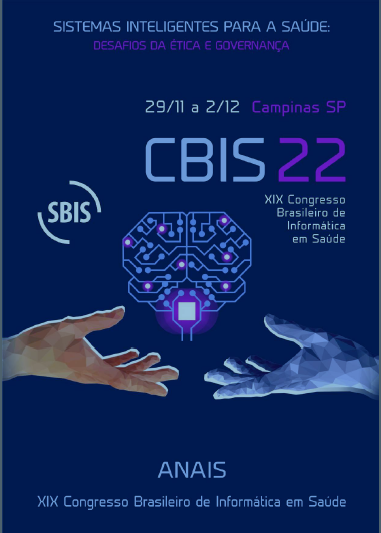Identificación de la Enfermedad de Alzheimer a Través del Habla Mediante el Reconocimiento de Emociones
DOI:
https://doi.org/10.59681/2175-4411.v15.iEspecial.2023.1093Palabras clave:
Enfermedad de Alzheimer, Análisis Automático del Habla, Aprendizaje AutomáticoResumen
La enfermedad de Alzheimer es la demencia neurodegenerativa más común en personas mayores en el mundo y su diagnóstico requiere una amplia evaluación médica, apoyada en pruebas cognitivas, exámenes clínicos y de imagen. Identificar la enfermedad a través del habla puede reducir el tiempo del diagnóstico. Los estados emocionales son importantes indicadores de rendimiento de los procesos cognitivos. Técnicas computacionales inteligentes pueden convertirse en herramientas relevantes para un diagnóstico médico temprano. Este artículo aborda el uso del reconocimiento de emociones a través de la voz como biomarcador para identificar la presencia de la enfermedad de Alzheimer. El método propuesto se basa en la extracción de características emocionales del habla y el reconocimiento de patrones mediante redes neuronales multicapa. Los resultados de los experimentos alcanzaron una exactitud del 72,61 %, una precisión del 72,90 % y una exhaustividad del 72,50 % mediante la validación cruzada de los datos.
Citas
who.int [Internet]. Ageing - World Health Organization; c2022 [cited 2022 Aug 27]. Available from: https://www.who.int/health-topics/ageing.
Gauthier S, Webster C, Servaes S, Morais JA, Rosa-Neto P. World Alzheimer Report 2022: Life after diagnosis: Navigating treatment, care and support. London, England: Alzheimer’s Disease International (ADI); 2022.
Vizza P, Tradigo G, Mirarchi D, Bossio RB, Lombardo N, Arabia G, et al. Methodologies of speech analysis for neurodegenerative diseases evaluation. International Journal of Medical Informatics. 2019 Feb;122:45–54.
Alzheimer's Association. 2022 Alzheimer's Disease Facts and Figures. Chicago: Alzheimer's Association; 2022.
Liu L, Zhao S, Chen H, Wang A. A new machine learning method for identifying Alzheimer’s disease. Simulation Modelling Practice and Theory. 2020 Feb;99:102023.
Sharma P, Sharma A, Fayaz F, Wakode S, Pottoo FH. Biological signatures of Alzheimer Disease. Current Topics in Medicinal Chemistry. 2020 Apr 1;20.
Pulido MLB, Hernández JBA, Ballester MÁF, González CMT, Mekyska J, Smékal Z. Alzheimer’s disease and automatic speech analysis: A review. Expert Systems with Applications. 2020 Jul 15;150:113213.
Haider F, de la Fuente S, Albert P, Luz S. Affective Speech for Alzheimer’s Dementia Recognition. In Kokkinakis D, Lundholm Fors K, Themistocleous C, Antonsson M, Eckerström M, editors, LREC: Resources and Processing of linguistic, para-linguistic and extra-linguistic Data from people with various forms of cognitive/psychiatric/developmental impairments (RaPID). European Language Resources Association (ELRA). 2020. p. 67-73
de la Fuente Garcia S, Haider F, Luz S. Cross-corpus Feature Learning between Spontaneous Monologue and Dialogue for Automatic Classification of Alzheimer’s Dementia Speech. 2020 42nd Annual International Conference of the IEEE Engineering in Medicine & Biology Society (EMBC). 2020 Jul 20-24; Montreal, Canada. p. 5851-5855
Campbell EL, Mesía RY, Docío-Fernández L, García-Mateo C. Paralinguistic and linguistic fluency features for Alzheimer’s disease detection. Computer Speech & Language. 2021 Jul;68:101198.
Burkhardt F, Paeschke A, Rolfes M, Sendlmeier WF, Weiss B. A database of German emotional speech. In: Ninth European Conference on Speech Communication and Technology; 04-08 de setembro de 2005; Lisboa, Portugal. INTERSPEECH 2005. p. 1517-1520.
Becker JT, Boiler F, Lopez OL, Saxton J, McGonigle KL. The natural history of Alzheimer's disease: Description of study cohort and accuracy of diagnosis. Archives of Neurology. 1994 Jun; 51 (6): 585-594.
Husein Z. Malaya, Speech-Toolkit library. Version 1.2.7 [software]. 2020 [cited 2022 Aug 27]. Available from: https://github.com/huseinzol05/malaya-speech.
Wagner J, Triantafyllopoulos A, Wierstorf H, Schmitt M, Eyben F, Schuller BW. Dawn of the transformer era in speech emotion recognition: closing the valence gap. arXiv:2203.07378v2 [Preprint]. 2022 [cited 2022 Aug 27]: [25 p.]. Available from: https://arxiv.org/abs/2203.07378v2
Braga AC, Oliveira P. Diagnostic analysis based on ROC curves: theory and applications in medicine. International Journal of Health Care Quality Assurance. 2003 Jul 1. p. 191-198.
Descargas
Publicado
Cómo citar
Número
Sección
Licencia
Derechos de autor 2023 Guilherme Bernieri, Julio Cesar Duarte

Esta obra está bajo una licencia internacional Creative Commons Atribución-NoComercial-CompartirIgual 4.0.
La sumisión de un artículo a el Journal of Health Informatics es entendida como exclusiva y que no esta siendo considerado para publicación en otro periódico. La permisión de los autores para la publicación de su artículo en lo JHI implica en la exclusiva autorización concedida a los editores para su inclusión en la revista. Al someter un artículo, a lo autor será solicitada la permisión electrónica de una Nota de Copyright. Una mensaje electrónica será enviada a lo autor correspondiente confirmando el recibo del manuscrito y lo aceite de la Nota de Copyright.


